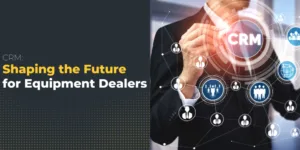Organizations seeking to improve equipment business profitability and operational efficiency are discovering the value of sharing data across their rental, dealership, and servicing departments. Traditionally, equipment businesses have operated in silos, with each department working independently. It can lead to inefficiencies and missed opportunities, negatively impacting profitability. How might sharing data help streamline operations throughout the business?
In the fast-paced equipment business world, sharing data between partners, dealers, and customers is integral to daily operations. In this blog, we have discussed the various aspects and advantages of sharing data throughout the equipment business.
Benefits of Sharing Data for Equipment Optimization
Sharing data within the equipment business sector can significantly enhance operational efficiency and equipment lifecycles. Let’s delve into the multifaceted benefits of using shared data strategically.
Enhanced Service and Maintenance Schedules
Access to shared data allows businesses to optimize their service and maintenance schedules, preventing downtime and costly repairs. Service schedules can be aligned more precisely with equipment needs by leveraging performance insights from similar equipment across different companies rather than relying on generic guidelines.
Improving Equipment Performance and Longevity
Sharing data contributes to an in-depth understanding of equipment performance under various conditions. This knowledge not only enables businesses to take corrective actions that boost efficiency but also aids in enhancing the longevity of the equipment, ultimately reducing the total cost of ownership.
Improved Customer Service
Sharing data between rental, dealership, and servicing departments can help teams provide better customer service through awareness. For example, if the rental department knows that a customer’s equipment is due for service, they can proactively contact the customer and schedule a service call.
Streamline Fleet Management
Sharing data between departments also helps manage inventory more effectively. For example, if the rental department is notified that equipment is due for service, they can take it out of circulation and send it to the servicing department for maintenance, reducing downtime and ensuring the fleet is rental-ready.
Increase Cross-Selling
Departments that share data can identify cross-selling opportunities. If a customer frequently rents a specific piece of equipment, the dealership department can contact the customer and proactively offer to sell them that asset model. Or, if information from the servicing department is readily accessible, the rental department can determine exactly when an asset will be ready to be rented out.
Inform Decision Making
Finally, sharing data helps companies to make better business decisions. With comprehensive data across the entire organization, team members can identify if there is high demand for an asset, leading to more dealership sales, or they can better understand what various industries are currently demanding, shaping choices throughout the year.
Pro Tip: Leverage shared data to create predictive maintenance schedules tailored to your specific equipment usage, significantly reducing downtime and repair costs while boosting overall operational efficiency.
Best Practices for Secure Data Sharing Among Equipment Businesses
| Category | Best Practices |
| Frameworks and Protocols | End-to-end encrypted data transmission to prevent interception by unauthorized parties. |
| Secure storage solutions, such as encrypted databases for protecting stored data. | |
| Regular security audits and vulnerability assessments to identify and mitigate potential risks. | |
| Adherence to industry-standard security certifications and compliances. | |
| Training Team Members | Conduct regular training sessions for team members on the latest data security practices. |
| Establish clear guidelines for handling sensitive data and reporting security incidents. | |
| Encourage a culture of security mindfulness throughout the organization. | |
| Implementing Access Controls and Data Governance Policies | Role-based access controls (RBAC) to enforce minimum necessary access based on job functions. |
| Comprehensive data governance policies outlining how data is collected, handled, and disposed of. | |
| Multi-factor authentication (MFA) adds an extra layer of security for data access. | |
| Audit trails to track access and changes to sensitive data. |
By following these best practices, equipment businesses can foster a secure environment for data sharing. It protects against external threats and fortifies internal safeguards, upholding integrity and trust in business operations.
The Role of IoT (Internet of Things) in Data Sharing
IoT has revolutionized the equipment business, providing unprecedented opportunities for efficiency and interconnectivity. By embedding sensors and internet connectivity into physical assets, IoT enables data to be shared seamlessly across various devices and platforms, leading to smarter equipment management.
Leveraging IoT for Smarter Equipment Management
With IoT technology, businesses can continually monitor the performance and condition of their equipment in real-time. It enables predictive maintenance, minimizes downtime, and optimizes asset utilization. IoT sensors can collect a myriad of data points, from temperature to vibration, and this data is crucial for making informed decisions that impact operational efficiency.
Achieving Seamless Interoperability with Smart Technology
One of the most significant advantages of IoT in the equipment business is its ability to achieve seamless interoperability. By standardizing data formats and communication protocols, equipment from different manufacturers can communicate and share data, providing a more integrated and automated approach to equipment management.
Addressing IoT Security Concerns in Equipment Businesses
Despite the benefits, IoT integration comes with potential security vulnerabilities that equipment businesses must proactively address. Protecting the data collected, transmitted, and shared through IoT devices is critical. Implementing robust security measures, such as encryption and secure authentication, is crucial to safeguard sensitive information from unauthorized access and cyber threats.
- Adoption of end-to-end encryption protocols to secure data transmission
- Regular firmware updates and patches to address vulnerabilities
- Access control policies and network segmentation to protect IoT devices
- Comprehensive risk assessments to identify and mitigate potential threats
Integrating IoT in the equipment business opens up many possibilities for improved efficiency and innovation in data sharing. However, companies must recognize and strategically manage the security implications to fully harness the potential of IoT without compromising data integrity.
Pro Tip: To fully harness the potential of IoT in equipment management, prioritize the implementation of end-to-end encryption and regular firmware updates to safeguard data integrity and protect against security vulnerabilities.
Data Standardization for Interoperability
The Importance of Standardized Data Formats for Compatibility: Data-sharing between different systems and organizations can be fraught with challenges in the equipment business. One of the main obstacles is the sheer diversity of data formats and protocols, which can hinder the seamless interchange of important information. Standardizing data formats ensures that information is interpretable across various systems, paving the way for interoperability and more comprehensive data analysis.
Benefits of Adopting Industry-Wide Data Standards
Adopting industry-wide data standards has numerous advantages. It ensures that different equipment providers and users can communicate effectively without resorting to cumbersome data translation processes. It, in turn, enhances collaboration, reduces the margin for error, and streamlines operations. Additionally, it supports compliance with regulatory requirements, as uniform data structures are easier to monitor and audit.
Steps to Ensure Data Consistency Across Different Systems
- Identifying and employing widely accepted international and industry-specific data standards.
- Developing clear data governance policies to manage data entry, storage, and sharing practices.
- Utilizing software and platforms capable of supporting standardized data formats.
- Training personnel on the importance of data standardization and consistency in data entry and management.
- Periodically reviewing data processes to ensure continuous alignment with evolving data standards.
By integrating these steps into company practices, businesses can significantly enhance their interoperability, leading to more efficient operations and better-informed business decisions.
Use Cases for Shared Data in Preventive Maintenance
Data sharing is transforming how businesses handle preventive maintenance in the equipment industry. By leveraging shared data effectively, companies can streamline service schedules and minimize equipment downtime. Let’s explore some of the most impactful use cases.
Revolutionizing Service Schedules and Reducing Downtime
Through the communal knowledge gained from shared data, businesses can optimize service schedules, conducting maintenance only when it’s truly needed rather than following a strict timetable. This strategy reduces unnecessary downtime and saves costs from premature servicing.
Predictive Analytics for Proactive Equipment Maintenance
Predictive analytics leverages patterns found in shared data to forecast potential equipment issues before they happen. By acting on these insights, businesses can prevent breakdowns, ensuring higher operational reliability and efficiency.
Learning from Shared Data to Avoid Common Equipment Failures
By analyzing shared operational data, companies can identify common failure modes. This critical analysis allows equipment businesses to make informed decisions that enhance the longevity and performance of their assets, avoiding the mistakes made by others in the industry.
Pro Tip: Utilize predictive analytics on shared data to foresee and address potential equipment issues before they occur, significantly enhancing reliability and reducing downtime for more efficient operations.
Data Ownership and Governance Models in Equipment Business
Ensuring proper data ownership and governance is crucial for companies engaging in data-sharing activities in the equipment business. Clear data governance strategies protect all stakeholders and guarantee that data is used effectively, responsibly, and within legal boundaries.
Establishing Clear Models for Data Ownership Amongst Stakeholders
Identifying and documenting who owns the data within a shared ecosystem is imperative. It helps delineate responsibilities and rights, paving the way for seamless collaboration among equipment business stakeholders. It resolves potential disputes over data usage and sets the foundation for mutual trust.
Governance Strategies Ensuring Data is Used Ethically and Legally
Governance strategies are essential in governing shared data access, distribution, and usage. These frameworks ensure that all actions comply with ethical guidelines and legal standards, like the GDPR. They also ensure that data-sharing practices uphold the integrity and privacy of the involved parties.
Balancing Data Access with Confidentiality and Intellectual Property Rights
While openness in data sharing offers numerous benefits, it’s essential to balance this with the need to protect confidentiality and intellectual property rights. Implementing policies that control data access rights, maintain trade secrets, and respect the sensitive nature of business information is of utmost importance in establishing a trustworthy data-sharing environment.
By developing robust data ownership and governance models, equipment businesses can foster an environment where shared data can be a source of innovation and strategic advantage without compromising the stakeholders’ rights and trust.
Pro Tip: Document data ownership and access rights in your data governance model to ensure seamless collaboration and protect intellectual property within your equipment business.
The Impact of Data Sharing on Supply Chain Efficiency
Data sharing within the equipment business has become a modern supply chain management cornerstone. Efficiency gains are achieved through improved operational performance and the sophisticated coordination and visibility possible with seamless data exchange. This integration transforms how equipment businesses respond to market demands and manage their inventories, maintenance schedules, and overall logistical operations.
Streamlining Operations with Real-Time Data Exchange
Data exchange in real-time allows for quicker decision-making and more agile responses to changing market needs. Businesses can optimize operations, reduce downtime, and minimize delays by sharing data. It leads to a leaner operation with better resource utilization, often resulting in significant cost savings and productivity improvements.
Enhancing Visibility and Coordination in the Supply Chain
Visibility is key in managing complex supply chains effectively. Sharing data affords businesses a transparent view into each component of their supply chains, fostering proactive management and coordination. From sourcing materials to delivering finished goods, enhanced data visibility ensures each step is tracked and optimized for maximum efficiency.
Regulatory Compliance in Data Sharing: Navigating the GDPR Landscape
Ensuring business practices align with local and international laws is critical to data sharing in the equipment business industry. Companies exchanging vast amounts of information across borders must prioritize compliance with various regulatory frameworks to avoid costly penalties and maintain consumer trust.
GDPR as a Blueprint for Data Handling in Equipment Businesses
The General Data Protection Regulation (GDPR) sets a stringent data privacy and security standard and influences how equipment companies manage personal data. By adopting GDPR’s principles, businesses can comply with European regulations and strengthen their data protection measures globally. Key elements include obtaining explicit consent for data collection, ensuring data minimization, and implementing robust security protocols.
Continuous Learning and Adaptation to Evolving Regulations
As technology progresses and new challenges to privacy emerge, regulatory bodies frequently update their guidelines. Equipment businesses must adopt a proactive approach to continuous learning and adaptation to these evolving regulations. Staying informed and being prepared to adjust practices accordingly is vital for maintaining compliance and protecting the integrity of shared data.
- Regular training sessions for staff on data protection regulations
- Staying up-to-date with changes in privacy laws worldwide
- Conducting frequent audits to ensure continual compliance
Equipment businesses can safeguard against breaches and confidently participate in the data-sharing economy by dedicating resources to understanding and implementing regulatory compliance measures.
Pro Tip: Regularly update your team on data protection regulations and conduct frequent audits to ensure ongoing compliance, safeguard against potential breaches, and maintain consumer trust in your equipment business.
Leveraging Cloud Technology for Data Sharing
As the equipment business continues to evolve, harnessing the power of cloud technology is instrumental for efficient data sharing. Cloud-based solutions offer advantages over traditional methods, paving the way for enhanced data management and streamlined operations. With the cloud, equipment businesses can easily scale and adapt to changing demands without substantial upfront investments in IT infrastructure.
Advantages of Cloud-Based Solutions for Data Management
Cloud platforms provide a centralized repository for data that can be accessed from anywhere, anytime, ensuring that the most current data is always at your fingertips. This accessibility is crucial for decision-makers who require immediate insights to optimize equipment performance and business operations. Additionally, cloud services facilitate collaboration between different stakeholders, leading to improved problem-solving and innovation.
Scaling Up Operations with Cloud Services
With cloud services, equipment businesses can quickly scale their data management capabilities to match their growth. The flexibility offered by cloud platforms allows for seamless expansion without significant disruption to existing workflows. As your equipment business expands, your data-sharing mechanisms can grow correspondingly, providing the necessary agility to compete in a dynamic market.
Security Considerations When Using Cloud Platforms for Equipment Data
Security remains a top concern when dealing with sensitive equipment data on cloud platforms. Choosing the right provider involves assessing security protocols, compliance certifications, and data protection measures. It is vital to ensure that the chosen cloud solution aligns with industry standards and regulatory requirements to safeguard data against unauthorized access and cyber threats.
Pro Tip: Prioritize a thorough assessment of security protocols and compliance certifications when selecting a cloud provider for equipment data, ensuring robust protection against unauthorized access and cyber threats.
Enhancing Equipment Lifecycle Management Through Data
Effective management of equipment life cycles is essential for maximizing value and ensuring the longevity of assets in the equipment business. In the digital age, harnessing the power of shared data has emerged as a transformative strategy for lifecycle management. By integrating data into every phase of the equipment lifecycle, businesses can make smarter decisions that optimize the use and maintenance of their assets.
Maximizing Equipment Value with Shared Data
Using shared data effectively can significantly enhance the value of equipment throughout its lifecycle. Each information collected offers crucial insights that can lead to cost savings and performance improvements from the procurement phase to eventual disposal or resale. Data-driven strategies allow for detailed tracking and analysis of equipment health, utilization, and maintenance needs, fostering a more proactive approach to asset management.
Smart Decisions Informed by Data
When informed by robust data, decisions regarding asset management become vastly more strategic. Companies can use data to determine the most efficient use of equipment, identify potential issues before they become costly problems, and schedule maintenance more effectively. In turn, these smart decisions support higher equipment uptime, extend the life of the equipment, and contribute to a more stable operational environment.
Building a Feedback Loop for Continuous Improvement
- Data Usage Analysis: Analyzing how data can reveal patterns and efficiencies that can be replicated or scaled across different equipment or operational areas.
- Feedback for Future Purchases: Information gathered throughout the equipment’s life cycle can influence future purchasing decisions.
- Lifecycle Management Optimization: Continuous learning from data creates a feedback loop that can lead to the fine-tuning of lifecycle management practices.
Incorporating these feedback mechanisms ensures equipment lifecycle management is not static but a constantly evolving process that leverages historical and real-time data for continuous improvement. As the equipment industry increasingly embraces digital transformation, data is becoming the cornerstone of intelligent lifecycle management strategies that deliver tangible results.
Building Trust and Transparency in Data Exchange
In the equipment business, data-sharing facilitation holds tremendous potential for optimization and growth. However, to harness this potential fully, companies must prioritize cultivating trust and ensuring transparency in their data exchange practices. A framework of confidence and openness is paramount for effective collaboration between partners.
Cultivating a Culture of Openness in Data-Sharing Practices
Understanding the importance of forthright communication, equipment businesses are increasingly fostering a culture of highly open data sharing. It includes mutually understanding what data is shared, how it is utilized, and the resultant benefits. Such a culture not only promotes ethical data use but also contributes to enhanced mutual trust among stakeholders.
Using Transparent Processes to Strengthen Partnerships
The adoption of transparent processes is integral to the formation of strong and lasting partnerships. By maintaining clarity around data collection, processing, and sharing methods, businesses reassure their partners of their commitment to fair practices. This transparency is a solid foundation for building resilient business relationships that can withstand the challenges of a dynamic market.
Advantages of Real-Time Data Sharing for Operational Decision Making
The competitive landscape of the equipment business deeply relies on data-driven decision-making for enhanced operational efficiency. Real-time data sharing emerges as a cornerstone in this process, offering numerous advantages to equipment businesses looking to optimize their operational decisions. Here are some of the key benefits:
Immediate Insights for Informed Decision-Making in the Field
Fast-paced environments demand real-time insights to make critical decisions on the spot. By leveraging real-time data sharing, decision-makers in the equipment business can access up-to-the-minute information, enabling them to respond promptly to operational challenges and opportunities—the ability to react quickly to live data results in more effective resource management and workforce deployment.
Dynamic Adjustments Based on Current Data to Improve Construction Outcomes
Construction projects often face unexpected changes that can cause delays or budget overruns. Real-time data sharing facilitates dynamic adjustments to the project workflow, ensuring that materials, manpower, and machinery are allocated efficiently. This agility can lead to an improvement in project timelines, quality, and overall construction outcomes.
Technological Solutions Enabling Real-Time Data Access and Analysis
Modern technology solutions, including IoT devices and cloud computing, have revolutionized how data is collected, shared, and analyzed. Equipment businesses can now harness these innovations to gain real-time access to data streams from various sources, allowing for instant analysis and interpretation. With this capability, businesses can identify trends, forecast potential issues, and implement solutions preemptively, ensuring continuous operational optimization.
- Strategic Planning: Data-driven strategies are formulated more accurately, leading to reduced risks and maximized resource allocation.
- Enhanced Collaboration: Seamless data sharing enables various stakeholders to synchronize efforts, enhancing teamwork and cooperative problem-solving.
- Continuous Improvement: With ongoing access to performance data, businesses can foster a culture of continuous improvement, making incremental changes that lead to long-term success.
Key Takeaways
- Sharing data between rental, dealership, and servicing departments enhances operational efficiency, optimizes service schedules, improves equipment performance, and boosts customer service by ensuring seamless communication and proactive maintenance.
- Implementing robust security measures, such as end-to-end encryption, regular security audits, role-based access controls, and multi-factor authentication, is essential to safeguard sensitive information and maintain data integrity within equipment businesses.
- Leveraging IoT technology for real-time monitoring and predictive maintenance and adopting standardized data formats facilitates smarter equipment management, seamless interoperability, and efficient data analysis across various systems and manufacturers.
- Real-time data sharing enables immediate insights for informed decision-making, dynamic operations adjustments, and continuous improvement. It also supports comprehensive lifecycle management, maximizing equipment value and informing strategic business decisions.
How Do You Share Data Securely In An Equipment Business?
Keeping your data in silos often creates obstacles to business success. With too many disparate systems, processes do not connect, and your team can’t operate at its fullest potential. Opportunities can be missed, effort can be wasted, and a lot of time is wasted performing manual tasks.
By leveraging purpose-built solutions like the Texada platform, equipment businesses are optimizing rental, sales, and service departments to reach their goals faster. When data is shared between advanced integrated solutions, businesses are better equipped for success.
So, speak to an expert today to discover how Texada Solutions can help you reach your next business milestone.



 June 27, 2025
June 27, 2025 3 minutes read
3 minutes read

